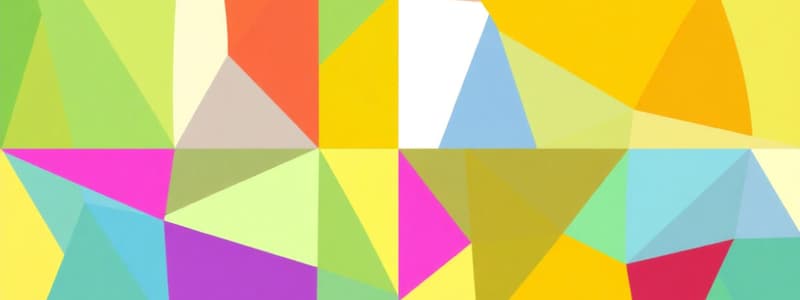Podcast
Questions and Answers
Point A is located 5 units to the left of the y-axis and 3 units above the x-axis. What are the coordinates of point A?
Point A is located 5 units to the left of the y-axis and 3 units above the x-axis. What are the coordinates of point A?
- (5, 3)
- (3, 5)
- (3, -5)
- (-5, 3) (correct)
A polygon is drawn on a coordinate plane with vertices at (1, 1), (4, 1), (4, 5), and (1, 5). What type of polygon is it?
A polygon is drawn on a coordinate plane with vertices at (1, 1), (4, 1), (4, 5), and (1, 5). What type of polygon is it?
- Triangle
- Trapezoid
- Rectangle (correct)
- Pentagon
A line segment on the coordinate plane has endpoints at (2, -3) and (2, 7). What is the length of this line segment?
A line segment on the coordinate plane has endpoints at (2, -3) and (2, 7). What is the length of this line segment?
- 14 units
- 5 units
- 4 units
- 10 units (correct)
A right triangle has vertices at (1, 1), (1, 5), and (4, 1). What is the length of the hypotenuse?
A right triangle has vertices at (1, 1), (1, 5), and (4, 1). What is the length of the hypotenuse?
A triangle with vertices at (0, 0), (2, 0), and (1, 2) is slid 3 units to the right. What are the new coordinates of the vertices?
A triangle with vertices at (0, 0), (2, 0), and (1, 2) is slid 3 units to the right. What are the new coordinates of the vertices?
A square with vertices at (1, 1), (2, 1), (2, 2), and (1, 2) is reflected over the x-axis. What are the new coordinates of the vertices?
A square with vertices at (1, 1), (2, 1), (2, 2), and (1, 2) is reflected over the x-axis. What are the new coordinates of the vertices?
A point at (1, 0) is rotated 90 degrees counterclockwise about the origin. What are the new coordinates of the point?
A point at (1, 0) is rotated 90 degrees counterclockwise about the origin. What are the new coordinates of the point?
Two parallel lines are cut by a transversal. Which of the following pairs of angles are always supplementary?
Two parallel lines are cut by a transversal. Which of the following pairs of angles are always supplementary?
Two parallel lines are cut by a transversal. One of the angles formed measures 60 degrees. What is the measure of its corresponding angle?
Two parallel lines are cut by a transversal. One of the angles formed measures 60 degrees. What is the measure of its corresponding angle?
Which of the following conditions must be met for a polygon to be considered regular?
Which of the following conditions must be met for a polygon to be considered regular?
Which of the following is true of a convex polygon?
Which of the following is true of a convex polygon?
A triangle has angles measuring 30 degrees, 60 degrees and 90 degrees. How can this triangle be classified?
A triangle has angles measuring 30 degrees, 60 degrees and 90 degrees. How can this triangle be classified?
A quadrilateral has two pairs of parallel sides, but no right angles, and all four sides are of equal length. How is it classified?
A quadrilateral has two pairs of parallel sides, but no right angles, and all four sides are of equal length. How is it classified?
Two parallel lines are intersected by a transversal. If one of the angles measures 110 degrees, what is the measure of the adjacent angle on the same line?
Two parallel lines are intersected by a transversal. If one of the angles measures 110 degrees, what is the measure of the adjacent angle on the same line?
A quadrilateral has only one pair of parallel sides. What type of quadrilateral is it?
A quadrilateral has only one pair of parallel sides. What type of quadrilateral is it?
If a polygon has an interior angle that measures 200 degrees, what type of polygon is it?
If a polygon has an interior angle that measures 200 degrees, what type of polygon is it?
A triangle has two sides that are equal in length. What classifications apply to this triangle?
A triangle has two sides that are equal in length. What classifications apply to this triangle?
Two angles are formed on the same side of a transversal intersecting two parallel lines. The angles are on the exterior of the parallel lines. The angles must be:
Two angles are formed on the same side of a transversal intersecting two parallel lines. The angles are on the exterior of the parallel lines. The angles must be:
A square is altered so that one pair of sides is stretched, while the other pair remain the same length. The angles are also not right angles. What shape has been created?
A square is altered so that one pair of sides is stretched, while the other pair remain the same length. The angles are also not right angles. What shape has been created?
What is the measure of an angle that is complementary to a 55-degree angle?
What is the measure of an angle that is complementary to a 55-degree angle?
Flashcards
Coordinate Plane
Coordinate Plane
A plane formed by the intersection of a horizontal number line (x-axis) and a vertical number line (y-axis).
Locate a Point
Locate a Point
To pinpoint the exact position of a point on a coordinate plane using an ordered pair of numbers (x, y).
Polygon
Polygon
A closed figure formed by three or more line segments.
Slide (Translation)
Slide (Translation)
Signup and view all the flashcards
Reflect (Reflection)
Reflect (Reflection)
Signup and view all the flashcards
Rotate (Rotation)
Rotate (Rotation)
Signup and view all the flashcards
Angles Formed by Transversal
Angles Formed by Transversal
Signup and view all the flashcards
Regular Polygon
Regular Polygon
Signup and view all the flashcards
Convex Polygon
Convex Polygon
Signup and view all the flashcards
Concave Polygon
Concave Polygon
Signup and view all the flashcards
Classify Triangles
Classify Triangles
Signup and view all the flashcards
Classify Quadrilaterals
Classify Quadrilaterals
Signup and view all the flashcards
Study Notes
- The chapter covers coordinate planes and geometry.
- Points are named and located on the coordinate plane.
- Polygons are drawn and identified on a coordinate plane.
- Lengths of horizontal and vertical line segments on a coordinate plane are determined.
- Side lengths of a right triangle are found.
- Figures are slid, reflected, and rotated on the coordinate plane.
- Angles formed when parallel lines are cut by a transversal are named.
- The measure of angles formed when parallel lines are cut by a transversal is found.
- Whether a polygon is regular is determined.
- Whether a polygon is convex or concave is stated.
- Triangles are classified.
- Quadrilaterals are classified.
Studying That Suits You
Use AI to generate personalized quizzes and flashcards to suit your learning preferences.




